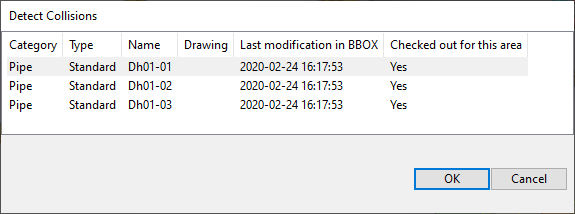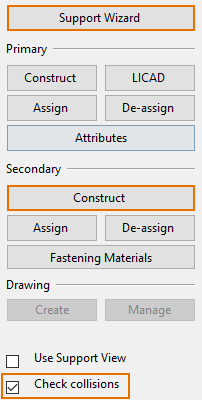Collision checking for supports
Support Designer can run collisions checks to investigate whether the parts of a support construction collide with each other or with other model objects.
-
The user can start collision checking by clicking Collisions in the Supports dialog.
-
The program runs collision checks automatically when returning from the Support Wizard or the Construct command of a secondary support and the Check collisions option is selected.
The parameters for accuracy and minimum clearance are set up in the configuration object Project Environment > [project] > Configuration > Support Designer > Configuration scripts for Support Designer ("Pm-Support/Configuration") , via the script function GetCollisionTestParameters(float accuracy_limit, float min_clearance) stored in the object.
Checking for collisions in supports
You can run collision checking on supports as described below.
Do the following:
-
Open the Pipe Supports, Duct Supports, or Cable Way Supports dialog of the relevant location plan as described in Pipe, duct, and cable tray supports, and click Collisions. The Detect Collisions dialog opens.
 Show/hide details
Show/hide details

Columns in this dialog:
Column
Description
Category
The discipline of the support:
- Pipe
- Duct
- Cable Way
Type
The type of the support:
- Standard
- Custom
Drawing
The name of the associated support drawing. (Only custom supports can have drawings.)
Last modification in BBOX
The latest modification time among the object which are inside or intersecting the combined minimum bounding box of the objects assigned to the support group.
Checked out for this area
Is the support group checked out to this Plant Modeller area:
- Yes
- No
-
Select a support from the list and click OK to start the check.
-
If any kind of collisions were detected, the Collision browser dialog opens for managing the collisions. For general information, see Collision browser.
Automatic collision checks
In the Supports dialog of pipes, air ducts or cable trays, if the Check collisions option is enabled, when the user has launched Support Wizard or the Construct tool of a secondary support and is returning to the Supports dialog, the program automatically checks the created supports for collisions.
First, two object sets are created. All objects in the first set are members in primary or secondary support groups of the selected supports. Collisions are detected between the two sets and the results are processed as described below.
Collisions whose status is "New" are changed to "Ignored" if they match the rules described below. Collisions with other status values are not changed.
Case A: Object 1 and object 2 are members in the same support group
|
Collision |
|
|
Support–primary vs. support–primary |
As is |
|
Support–primary vs. support–secondary |
Set to "Ignored" |
|
Support–secondary vs. support–secondary |
Set to "Ignored" |
|
Contact |
|
|
Support–primary vs. support–primary |
As is |
|
Support–primary vs. support–secondary |
Set to "Ignored" |
|
Support–secondary vs. support–secondary |
Set to "Ignored" |
|
Clearance violation |
|
|
Support–primary vs. support–primary |
As is |
|
Support–primary vs. support–secondary |
Set to "Ignored" |
|
Support–secondary vs. support–secondary |
Set to "Ignored" |
Case B: Object 1 is a member in a support group, object 2 is not a member in the same support group
|
Collision |
|
|
Support–primary vs. non-support object |
As is |
|
Support–secondary vs. non-support object |
As is |
|
Contact |
|
|
Support–primary vs. non-support object |
As is |
|
Support–secondary vs. non-support object |
Set to "Ignored" |
|
Clearance violation |
|
|
Support–primary vs. non-support object |
As is |
|
Support–secondary vs. non-support object |
As is |
If after this processing there still are collisions with the status "New", then the Collision browser dialog opens for managing the collisions. For general information, see Collision browser.

